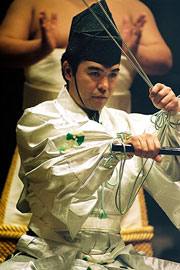
![]()
What Will Become of the Dynasty?
Brian Lewin
The Hanada Dynasty – past or present?
Rikishi of Old
Joe Kuroda
A look at a rikishi of yesteryear with Tenryu our man for August.
Heya Peek
John Gunning
John attends a chanko session at Chiganoura Beya.
Photo Bonanza
For a glimpse at some of the sights you won't see on TV.
July Basho Review
Lon Howard & John Gunning
Lon gives us his Nagoya Basho summary and his take on upset of the tournament while John chips in with his ‘gem’ of the basho.
Lower Division Rikishi
Mikko Mattila takes a break and Eric Blair covers the lower divisions in his own ‘unique’ way.
Aki Basho Forecast
Pierre Wohlleben & Mark Buckton
Pierre predicts the Aki Basho banzuke while Mark previews the ones to watch next time out.
Sumo 101
Barbara Ann Klein
Gyoji goings on and several things you never knew about the ones officiating.
Kimarite Focus
Mikko Mattila
Mikko walks us through his 2 chosen kimarite.
Minusha
John McTague
John's unique view of news from outside the dohyo.
Boletín de Sumo en Español
Eduardo de Paz Gútiez
An article on sumo’s very first fan mag – Boletin de Sumo en Espanol
Online Gaming
Jezz Sterling
Hear from the founder of Bench Sumo of one of sumo's most popular games.
Kokugi Connections
Todd Lambert
Todd’s focus on 3 of the most interesting online sumo sites today.
Fan Debate
Henka – good, bad or ugly? See what our debaters think.
Let’s Hear From You
What was it that made you a sumo fan – the Petros Zachos story.
Ngozi on the Road
Ngozi T. Robinson
NTR visits an amasumo event in the north-east U.S. and tells us what it was like.
Sumo Quiz
The Quizmaster
Answer the Qs and win yourself next basho's banzuke.
Gyoji are the only ones trained in this style of calligraphy. They accompany the elders who travel on sumo tours, often being the “advance men”, arranging transportation and keeping the accounts. As stadium announcers (in civilian clothing), they announce the bouts and the kimarite over the loudspeaker system. They confirm and record the results of the day’s bouts. They are also responsible for most of the paper work and sending out the banzuke for their respective heya, and, sometimes, ichimon (group of heya). In addition, the tate gyoji preside over the dohyo matsuri, or, ring blessing and dedication ceremony.
Gyoji enter sumo while still in their teens through application to a heya’s oyakata, and, after careful training – sumo calligraphy, holding the gunbai, calling the names, etc. – they rise through the eight gyoji ranks until mandatory retirement at age 65. A gyoji’s progression through the ranks is dependent upon the retirement or resignation of higher level referees as well as their own competence. The ranks’ designations are substantially the same as the rikishi, from jonokuchi to sanyaku. The highest rank is the tate gyoji, always called Kimura Shonosuke, who referees only
![]()
the final bout, followed by the fuku-tate gyoji, Shikimori Inosuke, who referees the two preceding bouts. All gyoji have one of two “family” names – Kimura (shade) or Shikimori (sun), and they may switch back and forth as they progress higher.
Each basho, the Kyokai gives the gyoji an allowance for his clothing and accessories. More often than not, though, at the higher levels, the outfits and the gunbai are presented to the gyoji as gifts from supporters. Some even receive hand-me-downs from gyoji who have gone on to a higher level!
The gyoji wears a type of a kimono called a “shozoku”, also called “hitatare”, which resembles the court dress worn by the samurai during the Kamakura period, and a lacquered gauze hat, or, “eboshi”, which is quite like a Shinto priest's hat. He carries a wooden fan, the “gunbai”. The gyoji ranks are easily differentiated by the quality and elaborateness of the garments worn. For makushita and lower ranks, the shozoku is made of cotton and is knee-length. Green rosettes adorn the outfit and the gyoji are required to be barefoot. Gyoji ranked at juryo and above wear more elegant, full
![]()
length silk garments, the weight of the silk dependent upon the season. At juryo level, the rosettes are green and white and the gyoji wear tabi (split-toed socks). After promotion to the makunouchi rank, the rosettes are changed to orange and white. Having reached the sanyaku level, the gyoji changes his rosettes once again, this time to orange and may wear both tabi and rope sandals on his feet. The fuku-tate gyoji changes his rosettes to purple and white while the tate gyoji wears solid purple tassels.
 The gunbai, a kind of heavy wooden fan which was originally used by generals to direct troops, also becomes more
The gunbai, a kind of heavy wooden fan which was originally used by generals to direct troops, also becomes more
Next Home
![]()